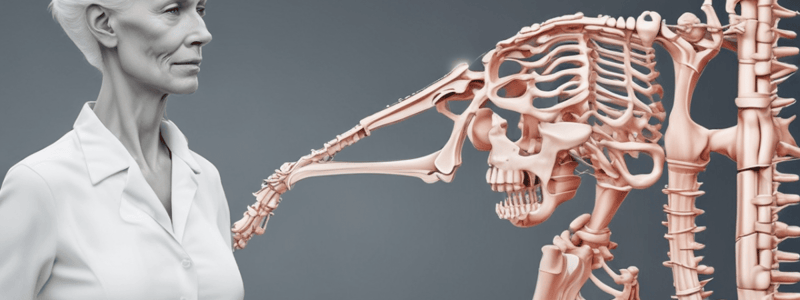Podcast
Questions and Answers
What is the primary method used to measure bone density, and what unit is it typically expressed in?
What is the primary method used to measure bone density, and what unit is it typically expressed in?
Dual-Energy X-ray Absorptiometry (DXA), grams per square centimeter (g/cm²)
What is the T-score range for osteoporosis, and what does it indicate?
What is the T-score range for osteoporosis, and what does it indicate?
T-score ≤ -2.5, bone density significantly lower than that of a healthy young adult
What are the three primary factors that increase fracture risk in individuals with osteoporosis?
What are the three primary factors that increase fracture risk in individuals with osteoporosis?
Age, previous fractures, and low bone density
What is the primary goal of hormone replacement therapy (HRT) in postmenopausal women, and what are the potential risks and side effects?
What is the primary goal of hormone replacement therapy (HRT) in postmenopausal women, and what are the potential risks and side effects?
What is osteopenia, and what lifestyle modifications are typically recommended to manage it?
What is osteopenia, and what lifestyle modifications are typically recommended to manage it?
What is the primary function of calcium in maintaining bone health, and what factors affect calcium absorption?
What is the primary function of calcium in maintaining bone health, and what factors affect calcium absorption?
What is the significance of a T-score between -1 and -2.5 in diagnosing bone density?
What is the significance of a T-score between -1 and -2.5 in diagnosing bone density?
What is the role of FRAX in assessing fracture risk, and what is the primary outcome measured?
What is the role of FRAX in assessing fracture risk, and what is the primary outcome measured?
What are the potential benefits of hormone replacement therapy (HRT) in preventing osteoporosis, and what population is it typically recommended for?
What are the potential benefits of hormone replacement therapy (HRT) in preventing osteoporosis, and what population is it typically recommended for?
What is the primary goal of calcium supplementation in individuals with osteoporosis, and what population may benefit from it?
What is the primary goal of calcium supplementation in individuals with osteoporosis, and what population may benefit from it?
Flashcards are hidden until you start studying
Study Notes
Bone Density
- Osteoporosis is characterized by low bone density, typically measured by Dual-Energy X-ray Absorptiometry (DXA)
- Bone density is measured in grams per square centimeter (g/cm²)
- T-score: compares bone density to that of a healthy young adult
- Normal: T-score ≥ -1
- Osteopenia: T-score between -1 and -2.5
- Osteoporosis: T-score ≤ -2.5
Fracture Risk
- Osteoporosis increases the risk of fractures, particularly in the spine, hip, and wrist
- Fracture risk assessment tools, such as FRAX, calculate the 10-year probability of a major osteoporotic fracture
- Factors that increase fracture risk:
- Age
- Previous fractures
- Family history
- Low bone density
- Certain medications (e.g., glucocorticoids)
Hormone Therapy
- Hormone replacement therapy (HRT) may be used to prevent osteoporosis in postmenopausal women
- HRT can help maintain bone density and reduce fracture risk
- However, HRT may have risks and side effects, such as increased risk of breast cancer and blood clots
Osteopenia
- Osteopenia is a condition where bone density is lower than normal, but not low enough to be classified as osteoporosis
- Osteopenia is often considered a precursor to osteoporosis
- Treatment for osteopenia typically involves lifestyle modifications, such as:
- Regular exercise
- Calcium and vitamin D supplementation
- Fall prevention strategies
Calcium Absorption
- Calcium is essential for bone health, and adequate absorption is critical for maintaining bone density
- Factors that affect calcium absorption:
- Vitamin D levels
- Hormonal status (e.g., parathyroid hormone)
- Gastrointestinal health
- Age
- Calcium supplementation can help improve calcium absorption, particularly in individuals with low dietary calcium intake or impaired absorption.
Bone Density Measurement
- Bone density is typically measured by Dual-Energy X-ray Absorptiometry (DXA)
- Measurement unit: grams per square centimeter (g/cm²)
Bone Density Classification
- T-score compares bone density to that of a healthy young adult
- Classification:
- Normal: T-score ≥ -1
- Osteopenia: T-score between -1 and -2.5
- Osteoporosis: T-score ≤ -2.5
Fracture Risk Factors
- Age increases fracture risk
- Previous fractures increase fracture risk
- Family history increases fracture risk
- Low bone density increases fracture risk
- Certain medications (e.g., glucocorticoids) increase fracture risk
Hormone Therapy for Osteoporosis Prevention
- Hormone replacement therapy (HRT) may be used to prevent osteoporosis in postmenopausal women
- HRT helps maintain bone density and reduces fracture risk
- Risks and side effects of HRT:
- Increased risk of breast cancer
- Increased risk of blood clots
Osteopenia
- Osteopenia: bone density is lower than normal, but not low enough to be classified as osteoporosis
- Often considered a precursor to osteoporosis
- Treatment for osteopenia involves:
- Regular exercise
- Calcium and vitamin D supplementation
- Fall prevention strategies
Calcium Absorption Factors
- Vitamin D levels affect calcium absorption
- Hormonal status (e.g., parathyroid hormone) affects calcium absorption
- Gastrointestinal health affects calcium absorption
- Age affects calcium absorption
Studying That Suits You
Use AI to generate personalized quizzes and flashcards to suit your learning preferences.




